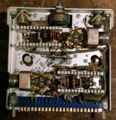661
The Tektronix 661 is a sampling oscilloscope that was made by Tektronix starting in 1961. It accepts two plug-ins: a sampling unit and a timing unit. Four sampling units were made: the 4S1 (0.35 ns rise time), the 4S2 and 4S2A (0.1 ns rise time), and the 4S3. Three timing units were made: the 5T1, 5T1A, and the 5T3. The timing units use tunnel diode triggering. Two 50-ohm coaxial cables in the scope connect the sampling unit to the timing unit. One cable sends the trigger pickoff signal (if available) from the sampling unit to the timing unit. The other cable sends the timing signal from the timing unit to the sampling unit, telling it when to sample.
The mainframe of the 661 is quite simple. It contains a calibration signal generator and a high-speed pulse generator, but otherwise it is just a low-speed X-Y indicator. The total CRT accelerating voltage is 3kV and the vertical and horizontal amplifiers are relatively mild differential amplifiers made of 6DJ8 tubes. The vertical amplifier has a feedback loop around it that determines the gain.
The amplitude/time calibrator is a Colpitts oscillator that uses a 7119 tube.
The sophistication of the 661 is all in the plug-ins. The signal from the calibration generator is available on the front panel and is also sent to the timing generator through the multi-pin plug-in connector. This allows the timing plug-ins to select "CAL" as a trigger source. In this mode, the calibration generator can be used as the stimulus for the device under test. In many situations, this eliminates the need for external triggering. When the timing unit triggers, a pulse is sent to the high-speed delayed pulse generator in the 661, which triggers and outputs a positive 250mV pulse about 400 nanoseconds long. The rising edge of this pulse is very fast.
The 4S2 is very similar to the 4S1, but has faster rise time. This is partly due to the elimination of the trigger pickoff and delay line on each channel. Since the 4S2 does not provide a pickoff signal to the timing plug-in, when using a 4S2 only one of the coaxial interconnect cables in the 661 carries a signal. The timing unit gets the trigger signal either from external input or from the internal pulse source in the 661.
Based on the available schematics, the 661 appears to have been designed in 1961. During what years was it manufactured? Why is it that the 661 has a dedicated high-speed coaxial interface between the sampling unit the timing unit while later 560-series sampling systems (3S2, 3T77A, etc.) are able to simply use the regular plug-in connector and mainframe wiring harness for routing trigger and timing signals between the two units?
Some 661s have a multipin connector on the rear panel, perhaps to allow the 661 to be interfaced to low speed data acquisition equipment or a computer.
- Tektronix 661 Manual (PDF)
- Late Issue Tektronix 661 Manual (PDF)
- 4S1 manual without schematics
- 4S1 schematics
- 4S2 schematics
- 4S2 complete manual
- 5T1A manual
- 5T3 manual
- Tektronix 661 Factory Calibration Procedure (PDF)
-
top internal view
-
front view
-
trace with 10 samples/cm and 2x horizontal expansion
-
left internal view
-
right internal view
-
top view of 4S1
-
Coaxial interconnect from timing plug-in goes through the mainframe, into the 4S1, and ends here, at the sampler.
-
This is the sampler. The GaAs sampling diodes are arranged in a diamond shape and are directly connected to the socket from the delay line.
-
The delay line is a coil of coax going from the trigger pickoff to the sampler.
-
The 661 mainframe has two pieces of 50-ohm coax that connect the sampling unit bay to the timing unit bay. The plug-ins engage with these interconnects when inserted.
-
4S2 top view
-
4S2 front view











